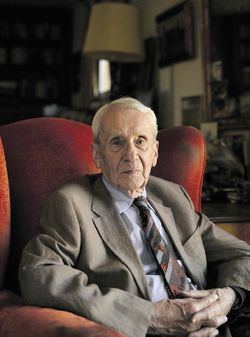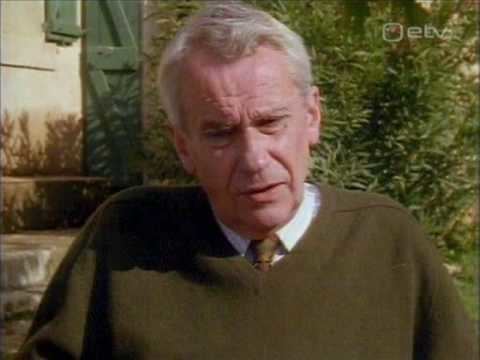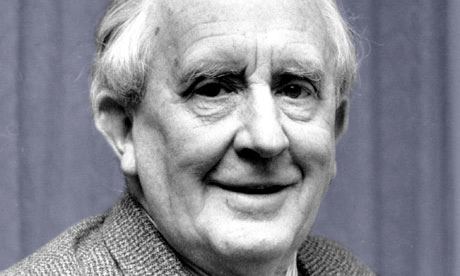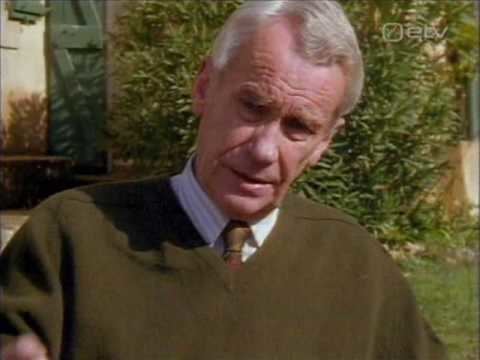Spouse Baillie Tolkien (m. 1967) Role Author | Name Christopher Tolkien | |
 | ||
Occupation Editor, novelist, academic Parents Edith Tolkien, J. R. R. Tolkien Children Simon Tolkien, Adam Reuel Tolkien, Rachel Clare Reuel Tolkien Siblings John Tolkien, Priscilla Tolkien, Michael Tolkien Books Unfinished Tales, The Letters of J R R Tolkien, The Legend of Sigurd an, Morgoth's Ring, The Peoples of Middle‑earth Similar People J R R Tolkien, Simon Tolkien, Edith Tolkien, Humphrey Carpenter, Alan Lee | ||
Christopher tolkien speaks about the silmarillion
Christopher John Reuel Tolkien (born 21 November 1924) is the third son of the author J. R. R. Tolkien (1892–1973), and the editor of much of his father's posthumously published work. He drew the original maps for his father's The Lord of the Rings, which he signed C. J. R. T.
Contents
- Christopher tolkien speaks about the silmarillion
- Christopher tolkien interview
- Early life
- Career
- Editorial work on J R R Tolkiens manuscripts
- Reaction to filmed versions of J R R Tolkiens works
- Personal life
- References

Christopher tolkien interview
Early life

Christopher Tolkien was born in Leeds, the third and youngest son of John Ronald Reuel Tolkien and his wife, Edith Mary Tolkien (née Bratt). He was educated at the Dragon School (Oxford) and later at The Oratory School.

He entered the Royal Air Force in summer 1943 and was sent to South Africa for flight training, completing the elementary flying course at 7 Air School, Kroonstad, and the service flying course at 25 Air School, Standerton. He was commissioned into the general duties branch of the Royal Air Force Volunteer Reserve on 27 January 1945 as a pilot officer on probation (emergency). He was given the service number 193121. He briefly served as an RAF pilot. He transferred to the Royal Navy Volunteer Reserve on 28 June 1945. His commission was confirmed and it was announced he was promoted to flying officer (war substantive) on 27 July 1945.
After the war he studied English at Trinity College at Oxford University, taking his BA in 1949 and his B.Litt a few years later.
Career
Tolkien had long been part of the critical audience for his father's fiction, first as a child listening to tales of Bilbo Baggins (which were published as The Hobbit), and then as a teenager and young adult offering much feedback on The Lord of the Rings during its 15-year gestation. He had the task of interpreting his father's sometimes self-contradictory maps of Middle-earth in order to produce the versions used in the books, and he re-drew the main map in the late 1970s to clarify the lettering and correct some errors and omissions. J. R. R. Tolkien invited Christopher to join the Inklings when he was twenty-one years old, making him the youngest member of the informal literary discussion society that included C. S. Lewis, Owen Barfield, Charles Williams, Warren Lewis, Lord David Cecil, and Nevill Coghill.
He published The Saga of King Heidrek the Wise: "Translated from the Icelandic with Introduction, Notes and Appendices by Christopher Tolkien" in 1960. Later, Tolkien followed in his father's footsteps, becoming a lecturer and tutor in English Language at New College, Oxford, from 1964 to 1975.
In 2016, he was given the Bodley Medal, an award that recognises individuals for outstanding contributions to literature, culture, science, and communication.
Editorial work on J. R. R. Tolkien's manuscripts
J. R. R. Tolkien wrote a great deal of material connected to the Middle-earth legendarium that was not published in his lifetime. Although he had originally intended to publish The Silmarillion along with The Lord of the Rings, and parts of it were in a finished state, he died in 1973 with the project incomplete. After his father's death, Christopher Tolkien, whom his father had once called his "chief critic and collaborator", embarked on organizing the masses of his father's unpublished writings, some of them written on odd scraps of paper a half-century earlier. Much of the material was handwritten; frequently a fair draft was written over a half-erased first draft, and names of characters routinely changed between the beginning and end of the same draft. In the years following, Christopher Tolkien worked on the manuscripts and was able to produce an edition of The Silmarillion for publication in 1977; his assistant for part of this work was the young Guy Gavriel Kay, who would later become a noted fantasy author.
Christopher Tolkien said, of assembling and editing The Silmarillion, "It became clear to me that to attempt to present, within the covers of a single book, the diversity of the materials – to show The Silmarillion as in truth a continuing and evolving creation extending over more than half a century – would in fact lead only to confusion and the submerging of what is essential. I set myself therefore to work out a single text, selecting and arranging in such a way as seemed to me to produce the most coherent and internally self-consistent narrative." Christopher Tolkien had to make some difficult editorial decisions in presenting his father's material, and both he and others have criticized some of these decisions.
The Silmarillion was followed by Unfinished Tales in 1980 and The History of Middle-earth in twelve volumes between 1983 and 1996; between HME and UT most of the original source-texts from which the 1977 Silmarillion was constructed have been made public. In April 2007 Christopher Tolkien published The Children of Húrin, whose story his father had brought to a relatively complete stage between 1951 and 1957 before abandoning it. This was one of J. R. R. Tolkien's earliest stories, its first version dating back to 1918; several versions of the story are published in The Silmarillion, Unfinished Tales and The History of Middle-earth. The Children of Húrin is a synthesis of these and other sources. Beren and Lúthien is the latest example of his editorial work and was published as a stand-alone book in 2017.
HarperCollins published other J. R. R. Tolkien work edited by Christopher Tolkien not connected to the Middle-earth legendarium. In May 2009 The Legend of Sigurd and Gudrún, a verse retelling of the Norse Völsung cycle, appeared, followed by The Fall of Arthur, in May 2013, and by Beowulf: A Translation and Commentary, Christopher Tolkien's edition of his father's translation of the Anglo-Saxon epic Beowulf, in May 2014.
Reaction to filmed versions of J. R. R. Tolkien's works
In 2001, he received some attention for his stance toward The Lord of the Rings film trilogy directed by Peter Jackson. He expressed doubts over the viability of a film interpretation that retained the essence of the work, but stressed that this was just his opinion. He voiced sharper criticism in a 2012 interview with Le Monde: "They gutted the book, making an action film for 15 to 25-year-olds."
In 2008 Christopher Tolkien commenced legal proceedings against New Line Cinema, which he claimed owed his family £80 million in unpaid royalties. In September 2009, he and New Line reached an undisclosed settlement, and he withdrew his legal objection to The Hobbit films.
Personal life
Christopher Tolkien currently lives in France with his second wife, Baillie Tolkien (née Klass), who edited J. R. R. Tolkien's The Father Christmas Letters for posthumous publication. They have two children, Adam Reuel Tolkien and Rachel Clare Reuel Tolkien. In the wake of a dispute surrounding the making of The Lord of the Rings film trilogy he reportedly disowned his son by his first marriage, barrister and novelist Simon Mario Reuel Tolkien, though they have since reconciled.
